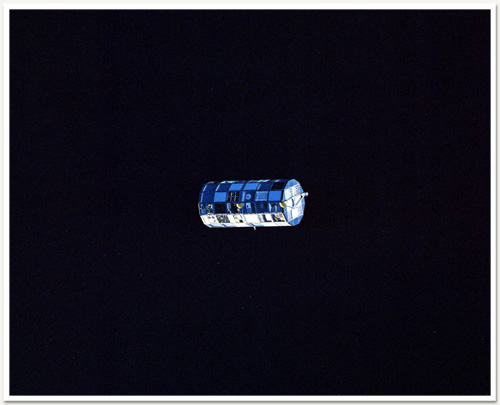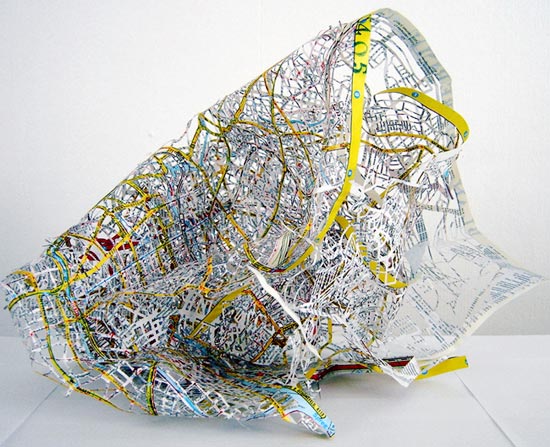One Hand Jason
Interview at BME with "One Hand Jason":
I’m one of those body-integrity-disorder (BIID) dudes. As long as I can remember, having two hands was a defect in my body — something that was not meant to be. For me philosophically, it’s totally different from body mods, which I also have. I don’t think I had any choice. My right hand just didn’t belong to my body.
Via Warren Ellis.
lowercase L
A blog dedicated to signs with letters in all-caps, except for the letter L.
Via Daring Fireball, Via Jonathan Rentzsch.
Learning to Lie
Po Bronson at New York Magazine:
It starts very young. Indeed, bright kids—those who do better on other academic indicators—are able to start lying at 2 or 3. “Lying is related to intelligence,” explains Dr. Victoria Talwar, an assistant professor at Montreal’s McGill University and a leading expert on children’s lying behavior.
Although we think of truthfulness as a young child’s paramount virtue, it turns out that lying is the more advanced skill. A child who is going to lie must recognize the truth, intellectually conceive of an alternate reality, and be able to convincingly sell that new reality to someone else. Therefore, lying demands both advanced cognitive development and social skills that honesty simply doesn’t require. “It’s a developmental milestone,” Talwar has concluded.
The most disturbing reason children lie is that parents teach them to. According to Talwar, they learn it from us. “We don’t explicitly tell them to lie, but they see us do it. They see us tell the telemarketer, ‘I’m just a guest here.’ They see us boast and lie to smooth social relationships.”
Consider how we expect a child to act when he opens a gift he doesn’t like. We instruct him to swallow all his honest reactions and put on a polite smile. Talwar runs an experiment where children play games to win a present, but when they finally receive the present, it’s a lousy bar of soap. After giving the kids a moment to overcome the shock, a researcher asks them how they like it. About a quarter of preschoolers can lie that they like the gift—by elementary school, about half.
Via Arts & Letters Daily.
'Kiosk' by Bruce Sterling
Bruce Sterling's Kiosk:
THE FABRIKATOR WAS UGLY, noisy, a fire hazard, and it smelled. Borislav got it for the kids in the neighborhood.
One snowy morning, in his work gloves, long coat, and fur hat, he loudly power-sawed through the wall of his kiosk. He duct-taped and stapled the fabrikator into place.
The neighborhood kids caught on instantly. His new venture was a big hit.
The fabrikator made little plastic toys from 3-D computer models. After a week, the fab's dirt-cheap toys literally turned into dirt. The fabbed toys just crumbled away, into a waxy, non-toxic substance that the smaller kids tended to chew.
Borislav had naturally figured that the brief lifetime of these toys might discourage the kids from buying them. This just wasn't so. This wasn't a bug: this was a feature. Every day after school, an eager gang of kids clustered around Borislav's green kiosk. They slapped down their tinny pocket change with mittened hands. Then they exulted, quarreled, and sometimes even punched each other over the shining fab-cards.
The happy kid would stick the fab-card (adorned with some glossily fraudulent pic of the toy) into the fabrikator's slot. After a hot, deeply exciting moment of hissing, spraying, and stinking, the fab would burp up a freshly minted dinosaur, baby doll, or toy fireman.
Foot traffic always brought foot traffic. The grownups slowed as they crunched the snowy street. They cast an eye at the many temptations ranked behind Borislav's windows. Then they would impulse-buy. A football scarf, maybe. A pack of tissues for a sneezy nose.
Once again he was ahead of the game: the only kiosk in town with a fabrikator....
Bit rough the first page or two, but gets better.
JG Ballard reminisces on his boyhood years
Excerpt from Miracles of Life by JG Ballard at Times Online
I looked down from my room on the 17th floor of the Hilton and could see at a glance that there were two Shanghais – the skyscraper city newer than yesterday and at street level the old Shanghai that I had cycled around as a boy.
Via cityofsound.
Long Duration Love Affair
JMorrison at the nonist:
That cylindrical object you see pictured above is a roughly school-bus sized structure which was deployed into space in 1984. It orbited the Earth for five and a half years with nothing expected of it other than to float there, getting battered about by whatever the great black yonder saw fit to throw at it. You see, every inch of its outside surface was covered with Science. 57 separate experiments, mounted in 86 trays, involving the participation of “more than 200 principal investigators from 33 private companies, 21 universities, seven NASA centers, nine Department of Defense laboratories and eight foreign countries.” Its purpose was to study the effects of space on a multitude of materials. Its name is the Long Duration Exposure Facility (LDEF) and I am deeply in love with it.
Via cityofsound.
Back by popular demand: the Minimal Compact
Ever since v-2.org went down for the count, I get a fair number of requests to repost this minifesto on “open-source constitutions for post-national entitites,” from 2003. It’s goofy, it’s naïve, it’s grandiose and pompous…and I present it to you now exactly as I wrote it then. Enjoy!
Commodity traders superior to chimpanzees, research shows
Alexander Campbell at Risk:
In a radical overturning of conventional wisdom, scientists in Georgia and California have found significant differences between commodity traders and chimpanzees. Chimps are, in fact, not very good at commodity trading.
Digital technology is transforming photojournalism
Andrew Blum in Hard Focus (Print Mag) reproduced on his site:
Gone are the days when photojournalists lugged a chunky Rolleiflex TLR into the field and sent film home on planes. Digital technology has streamlined the process—while adding a few of its own complications. To find out more about how technology is changing photojournalism, I tracked down a few of the conflict photographers who travel around the world from hot spot to hot spot
Via cityofsound.
BLDGBLOG: The Year in Review
I’ve been inspired to take a trip back through the archives here to see where we’ve been since January 2007. I’ll start with January, then do each month in a separate post. So if you’re new to BLDGBLOG, or even if you’ve been here all along, since our rather quiet start back in 2004, here’s a relatively good way to see what the site is all about.
January, February, March, April, May, Summer, Fall.
Via cityofsound.
Bruce Sterling: State of the World, 2008
Bruce does his annual "state of the world" conversation with Jon Lebkowsky and others on The WELL.
Children VS Artists
Jason at Rag & Bone
As a parent, I can attest to the wild imagination of children. I was a kid once too, and I remember. David Devries from South Orange New Jersey remembers too and transforms the drawings of children - with their wild imaginations for conjuring up monsters, superheros and creatures - into “adult” versions of their art.
Via Monoscope.
Eyescapes
A special project by Rankin “Eyescapes” at art-dept.
Via Marcus Trimble at Super Colossal.
Repressed Memory
Ashley Pettus in Harvard Magazine
In a recent study, professor of psychiatry Harrison Pope, co-director of the Biological Psychiatry Lab at Harvard-affiliated McLean Hospital, put “repressed memory” to the test of time. He reasoned that if dissociative amnesia were an innate capability of the brain—akin to depression, hallucinations, anxiety, and dementia—it would appear in written works throughout history. In collaboration with associate professor of psychiatry James Hudson, Michael Parker, a professor of English at the U.S. Naval Academy, Michael Poliakoff, director of education programs at the National Endowment for the Humanities, and research assistant Matthew Boynes, Pope set out to find the earliest recorded example of a “repressed memory.”
Via Arts & Letters Daily.
Rich Kid Syndrome
Jennifer Senior in New York Magazine
In 2000, there were 7,000 American households worth $100 million or more; in 2003, there were 10,000; and today, though the data isn’t yet in, Boston College estimates that the number will be 14,000 or 15,000, or double what it was at the beginning of the millennium. If you pare back the standard from eight zeroes to seven, the numbers are even more surprising: Boston College has calculated that in 2004, the last time the Fed provided data, there were 649,000 American households worth $10 million or more, a nearly 300 percent jump since 1992. […]
At some point, the offspring of this charmed class will be the stewards of the dollhouse nation their parents have created—and, more important, the caretakers of its treasury. Already, Boston College projects that inheritances received between 2003 and 2007 will be 50 percent larger than those received between 1998 and 2002, and that’s after adjusting for inflation.
The Metabolic City
Observers of Tokyo have for long admired its fluidity, its capacity to constantly reinvent itself and its ability of multiplying, juxtaposing, and overlaying functions. The history of Tokyo’s urban development in the past century is mainly one of incremental and spontaneous development of the parts assembling to form a whole. Modernizers have for long attempted to “rationalize” Tokyo, but were ultimately unable to cope with the extremely rapid demographic and urban expansion.What made this process quite distinctive (from other Asian urban histories) is that official policies did not dismiss the city’s organic evolution. The mixed-use habitats, the village like social foundations of the urban neighbourhoods and the low-rise high density landscape emerged as a default urban model. A model that was not seen as an ideal one by planners, but which also was not considered illegitimate.
See also Andrew Blum’s Local Cities, Global Problems.
Via cityofsound.
What is up with election coverage?
Posted to bramcohen.
The coverage of the current US primaries is mindbogglingly wrongheaded. Recent coverage has focused on who would ‘win’ New Hampshire among the democrats, and Huckabee’s ‘lead’ among republicans. The actual numbers can be found here. New Hampshire is not a winner-take-all state for democrats, and both Clinton and Obama got exactly nine delegates from there, making the declaration of a ‘winner’ extremely misleading, if not outright revealing of the declarer having dubious mental capacity. Among republicans, Mitt Romney now has the most delegates, with Huckabee in second, and the media is currently speculating that Romney will drop out because he’s so far ‘behind’.
Seriously, what is wrong with journalists? Are they not able to do basic arithmetic? Ideally I’d like to have meta-coverage discussing why some states are winner take all and others aren’t, and what on earth ‘super-delegates’ are, but I’d settle for even an accurate portrayal of what’s happening in the race as it unfolds.
But thank you CNN for putting up a nice site which gives accurate up-to-date information. Please expand it in the future with more explanation of what ‘super delegates’ are, and what happens to a candidate’s delegates if they drop out of the race.
The city as destructive system: wildfires, Dresden and the case against urban sprawl
Posted by Dan Hill to cityofsound.
Friedrich’s article, when taken with images of the wildfires in California, and those around Australian cities in recent years, gave me pause to consider how urban form and fire are related. I don’t want to use the terrible fires around California, and in Australia before them, as my own spurious token in an academic argument about urban planning. And yet I can’t help but correlate urban sprawl with placing more and more people into areas consistently threatened by fire. In this, the contemporary form of the sprawling city is not only something that is bad for the city in general - you could argue that point of course, but I don’t think it can really be doubted - but also just supremely dangerous.





